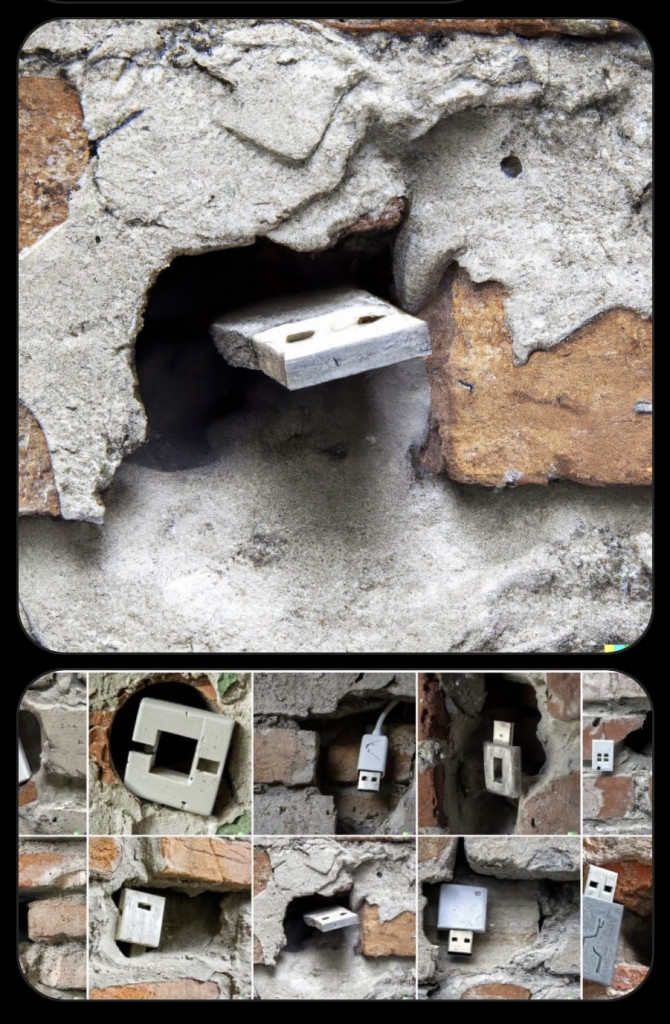DALL-E Dead Drops

The artist Fabiola Larios described the Dead Drops to the AI picture generating system DALL-E.
It resulted in these generated pictures! 👏👏… love it! Thx! :))
The World in My Hand explores the smartphone as both object and aesthetic inspiration for artistic creation. It comments on public debates surrounding the many uses of smartphones: from always-on media consumption to digital detox, from swiping and matching to ghosting and blocking, from language atrophy to information overload, from resource depletion to status symbol.
The curators, Dr Jörg Garbrecht and Katharina Wenkler, have chosen a narrative approach to the exhibition. In eight chapters, they summarize various aspects and debates surrounding the smartphone, ranging from the launch date of our daily digital companion to its characteristic touchscreen and the contractions of time and space it enables. Deeply personal moments – such as Ai Weiwei’s selfie at the moment of his arrest or Sergey Melnitchenko’s photograph of his son during a blackout in Kyiv – appear alongside themes of perception and presentation of the self, as realized in the glass sculpture Stability by Julija Pociūtė. Other subjects include: looking for love online, as in Ariane Forkel’s Casanova’s Kabinett or John Yuyi’s Tinder Match; the complexities and pitfalls of digital communication, for example in the works of James Akers or Alejandra Seeber; and the smartphone as a means of staying in touch during pandemic lockdown isolation, for instance in the work of George McLeod. Edward Burtynsky’s photograph of lithium mines in the Atacama Desert calls attention to the topic of raw materials for electronic devices.
With works by:
Tornike Abuladze, James Akers, Ai Weiwei, Kate Baker, Aram Bartholl, Tillie Burden, Edward Burtynsky, Yvon Chabrowski, Julia Chamberlain, Rachel Daeng Ngalle, Erwin Eisch, Ariane Forkel, Shige Fujishiro, Valentin Goppel, David Horvitz, Artem Humilevskyi, Gudrun Kemsa, Zsuzsanna Kóródi, Brigitte Kowanz, George McLeod, Sergey Melnitchenko, Jonas Noël Niedermann, Julian Opie, Cornelia Parker, Katie Paterson mit Zeller & Moye, Julija Pociūtė, Rebecca Ruchti, Karin Sander, Jeffrey Sarmiento, Alejandra Seeber, JanHein van Stiphout, Jolita Vaitkute, Sascha Weidner, John Yuyi, Jeff Zimmer
14:00 – 16:00
Killyourphone is an open workshop format. Participants are invited to make their own signal blocking phone pouch. In the pouch the phone can’t send or receive any signals. It is dead! This workshop was run for the first time at the Chaos Communication Congress in Hamburg end of 2013.
Monday 25th of March, 7:00 PM at Web Cafe, Eptanisou 40, 113 61 , Kypseli – Athens
with:
!Mediengruppe Bitnik with Selena Savić & Gordan Savičić , Ingrid Hideki, Joanna Bacas, Kyriaki Goni, Maria Mavropoulou, Marina Gioti, Marsunev, Nadja Buttendorf, Theo Triantafyllidis
Curated by Aram Bartholl & Socrates Stamatatos
Speed Show lands in Greece, the country of souvlaki, the sun (yes we can claim that they originated a celestial body), ouzo, feta, an enormous financial debt. Currently, Greece is also trending for all the wrong reasons namely, gentrification, queerphobia, state crimes and more dystopic incidents.
As 2024 unfolds, we find ourselves amidst a whirlwind of confusion, bombarded with a cacophony of online horrors to consume, an attention span further abbreviated by TikTok’s algorithm and the barrage of incoming stitches.
Stitches Incoming serve as a conduit for creators to engage and converse, traversing from one topic to the next. They have evolved into a new social fabric, weaving connections within an ever-shifting digital and physical landscape while also serving as a testament to personal and collective traumas, both past and present.
What unites the participating digital artists? Perhaps everything and nothing simultaneously… Departing from the traditional Speed Show setup, where artworks are carefully stacked inside internet cafe computers, and drawing inspiration from the structure of TikTok stitches, each piece seems to propel the conversation forward, or perhaps uses the next as a springboard for its own narrative.
Stitch this and stitch that, we have everything you ever wanted (maybe) ! Are we stuck in an infinite loop of sh*tposting, valuable content, the highlight of social issues, personal and interpersonal experiences?
Maybe! Come and find out…
More info on Speed Shows at https://speedshow.net/stitch-incoming/
14:00 – 16:00
Killyourphone is an open workshop format. Participants are invited to make their own signal blocking phone pouch. In the pouch the phone can’t send or receive any signals. It is dead! This workshop was run for the first time at the Chaos Communication Congress in Hamburg end of 2013.
14:00 – 16:00
Killyourphone is an open workshop format. Participants are invited to make their own signal blocking phone pouch. In the pouch the phone can’t send or receive any signals. It is dead! This workshop was run for the first time at the Chaos Communication Congress in Hamburg end of 2013.

The artist Fabiola Larios described the Dead Drops to the AI picture generating system DALL-E.
It resulted in these generated pictures! 👏👏… love it! Thx! :))